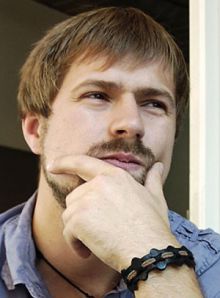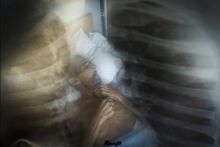Last year Kyiv photographer Maksym Dondiuk was one of the winners of the 13th All-Ukrainian Photo Contest of Den/The Day with a series of his works “Tuberculosis. 10 thousands every year.” He has been working with TB infected people for two years in order to reduce the estrangement of the society from these people. He has been doing so in a radical and extremely risky way by deliberately refusing to put on a protection mask, seeking to be in the same conditions as the heroes of his project (for example, he resided at a TB clinic while making the Kherson series of photos).
Maksym writes in his blog that he believes in power of photography, that it can change the life and destiny of people. His photos reflect the problem which has become a national one. In his photos there is no room for cynicism, black-and-white colors, Photoshop, or staging. His photos are realistic and painful, maybe that is the reason why they draw the attention of people.
Maksym’s photos are published in foreign periodicals. His work TB Epidemic in Ukraine is a winner of foreign photo contests.
March 24 is the World Tuberculosis Day. Ukraine has held certain actions too. Namely the initiative of individuals helps to somewhat improve the catastrophic situation: 70,000 Ukrainians have a stable form of this disease.
Why people with tuberculosis are in the focus of your camera?
“Several years ago I worked as a photo journalist, mostly focused on political themes. Sometimes I was tasked with shooting serious things on social topics, but that was quite rare. After all, I took interest in a long-time recreation of an atmosphere. My friend Mykhailo, who works in the international organization ‘Doctors without Borders’ in New York, for the first time shed light for me on the problem of tuberculosis in Ukraine. He told me how difficult it is to get to the prisons where people with TB are kept. In May 2010 I came up with an idea to create this project. At that time I was sure that several months would be enough to travel across Ukraine and shoot everything. But the shooting started only in December. It took so long to get an official permission to shoot in hospitals and prisons.
“I appealed wherever I could, to no avail. Only the Rozvytok Ukrainy (Ukraine’s Development) Foundation responded. They introduced me to the chief doctor of Donetsk oblast, who helped me to get to clinics and pretrial detention centers. I was shooting in Donetsk till March, and in Kherson – in June.”
Has the situation improved within the two years of your work, for according to the data of the Ministry of Health of Ukraine, the epidemic, which has been raging since 1995 in our country, is going down.
“I have recently been invited to Shuster Live as a specialist and we had a heated debate concerning the numbers which were announced. This is simply a delusion. They take the best of the best stats and put them together.
“I have shot only in two regions, so I cannot say for entire Ukraine. In Donetsk the situation is somewhat better owing to the Akhmetov Foundation. In Kherson, I saw a complete disaster. The chief doctor cannot do anything because there is no money. The patients with the initial stage of the disease are able to pay for their treatment, but everything is much more serious with the stable form: there is no funding, a mere seven hryvnias is allotted for food per day. The diseased are given two pieces of bread in the morning and they have to stretch them out for the whole day, whereas soup is thinner than coffee. There are people with no money at all, they simply die. I come to the clinic where the patients understand that some of them may die tomorrow, the day after tomorrow, but there is nothing they can do.
“Frequently because of the state’s negligence (like missing a tender, for example) the prisoners start a course of strong antibiotics, which is never completed. After the release, when they want to complete the treatment, they come to civil hospitals where they get an answer, ‘Sorry, we have no such medicines, we have no money for them.’ As a result, the tuberculosis enters the stable form which is hard to be cured. As a rule, the quality of treatment is better in prisons: they are under control of another ministry, the discipline is higher, besides there are foreign inspections. When international observers make a conclusion on the situation in prisons, they assume that the situation in hospitals is better a priori.”
How much money do you need for treatment?
“I am not a doctor, but according to rough calculations, simply to sustain your vital activity, you need 1,500 hryvnias per month. This does not include meals, or complete course, this is just not to die. However, the treatment of TB should be systemic: if they prescribe five medicines, there should be five of them, otherwise everything will be in vain and the course won’t give any results. The doctors often say, take these first, then – those. This may lead to development of multiresistance of the disease. Besides, the nutrition should be perfect. You can lose up to 15 kilos when you eat well, and in the hospitals the diet is just primitive.
“By the way, the Crimea is one more problem territory. Most of amnestied people go to work there in summer: there is season work and it is warm. So I want to check whether people with TB forms work in resorts.”
This looks like a theater of the absurd.
“One penitentiary where prisoners with TB are kept, when we had an epidemic of swine flu, received an order for sewing 5,000 gauze bandages. The administration of the prison wrote a letter in reply, say, come to your senses, we have prisoners with an active form. And the ministry replied: every penitentiary should send a certain number of masks. The administration of the prison should be paid its due, because it found the money to buy gauze bandages from the drugstore and sent it to the ministry.
“One more example. A severe regime prison where prisoners with TB are kept is located in the center of Kherson. It is surrounded by a park, there is a quay nearby, i.e., the places where young people mingle. I talked to those who recreate on the quay: they all knew that there was a prison nearby, but few people knew that it was a TB prison. And this kind of facilities should be located at least 70 kilometers away from cities. And the head of the prison says that it can be moved, all papers are ready, there are businessmen eager to build a trade and entertainment complex on that place (if they lease it for 50 years). But everything is deadlocked by lack of several signatures in the oblast council or city executive committee. And in a five-year term the money from the lease could be used for building a new prison outside the city, with a village for the service staff. That would be better for everyone.”
Since Soviet time we’ve had a stereotype that TB is a disease of socially unprotected people. Does it still exist in modern Ukrainian society?
“Society is deceived, it begins to avoid such people, thinking that only drug and alcohol addicted people can get infected. In fact, anyone can get infected. There are active and passive forms. A person with a passive form presents no danger. For example, such a diseased can undergo a six-month treatment, recover, and pose no danger at all. There are extrapulmonary forms: TB of kidneys, liver and other organs: they are not contaminative either. What does the surrounding of the diseased people do for the most part? They immediately forbid their children to talk to them, the neighbors will stop talking to them, inviting them to birthday parties.
“The Western system of treatment, like in Baltic states, is very efficient. The diseased with an active form are kept in a facility, and family or friends can take them from there only when they completely recover. The hospital’s floors are completely isolated. All needed conditions are created for the patients. And in Ukraine, when the patient is freezing, there are no medicines or food, he has to go home, take some food, or go to the drugstore to buy medicines, and work up somewhere if he has such an opportunity.
“On the other hand, when the TB form is safe for the surrounding, the society still estranges these people. It is hard to find a job even for those who have completely recovered, people are afraid to hire them. The chief doctor of a Kherson hospital told me that doctors who were fired from other hospitals for having tuberculosis work in his hospital.”
Last year you organized an action in the Kyiv railway station.
“On March 24, on the World Tuberculosis Day, the employees of Akhmetov Foundation and I put on the balcony of the second floor of the South Railway Station the placards with the photos of the diseased, so that one could see them from everywhere, so that people looked at them and understood what could happen if they don’t undergo any treatment. And one could get a medical consultation nearby.
“A mobile X-ray apparatus was located below for the two weeks the kind of exhibit was taking place. Everyone willing could check their state of health and get the results within a mere 15 minutes. Several people were diagnosed with lung diseases, two people – with a hard active form of tuberculosis.”
What actions will take place this month?
“The Ministry of Health of the Autonomous Republic of the Crimea is organizing a month of combating tuberculosis, which aims to inform the population about the symptoms, treatment, and prophylactic measures. (By the way, they found me themselves, which surprised me.) Billboards with my photos and a text will be installed on the roadside across the peninsula to stay there for the whole March.
“In Donetsk a thematic exhibit will also take place till April 2. A six-meter-high banner has been placed on roadsides featuring people who are dying from tuberculosis. Hopefully, these boards will produce a strong effect. Since the exhibit is organized by the Akhmetov Foundation, besides the residents of the city, high-ranking officials will be invited too, to see everything with their own eyes. The most important thing is to break the stereotypes and try to achieve understanding that anyone can get infected with TB, so such diseased should not be estranged from the rest of the society.”
TO THE POINT
Maksym Dondiuk is the finalist of the Photo Evidence Book Award 2012 with his series of work about the TB epidemic in Ukraine. Along with the best works of other participants the photos of the documentary photographer will be on display at the gallery of the VII Photo Agency. In October this year a collective exhibit will take place in New York.








